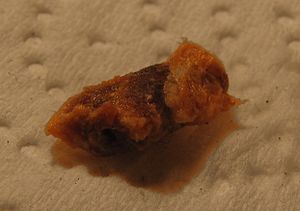Earwax
| Earwax | |
|---|---|
 |
|
| Wet-type human earwax | |
| Pronunciation | cerumen /səˈruːmɛn/ |
| Classification and external resources | |
| Specialty | Otorhinolaryngology |
| MedlinePlus | 000979 |
| Patient UK | Earwax |
Earwax, also known as cerumen, is a yellowish waxy substance secreted in the ear canal of humans and other mammals. It protects the skin of the human ear canal, assists in cleaning and lubrication, and also provides some protection against bacteria, fungi, insects and water.
Earwax consists of shed skin cells, hair, and the secretions of the ceruminous and sebaceous glands of the outside ear canal. Major components of earwax are long chain fatty acids, both saturated and unsaturated, alcohols, squalene, and cholesterol. Excess or compacted cerumen can press against the eardrum or block the outside ear canal or hearing aids, potentially causing hearing loss.
Cerumen is produced in the outer third of the cartilaginous portion of the ear canal. It is a mixture of viscous secretions from sebaceous glands and less-viscous ones from modified apocrine sweat glands. The primary components of earwax are shed layers of skin, with, on average, 60% of the earwax consisting of keratin, 12–20% saturated and unsaturated long-chain fatty acids, alcohols, squalene and 6–9% cholesterol.
There are two distinct genetically determined types of earwax: the wet type, which is dominant, and the dry type, which is recessive. While Asians and Native Americans are more likely to have the dry type of cerumen (gray and flaky), African and European people are more likely to have the wet type (honey-brown to dark-brown and moist). Cerumen type has been used by anthropologists to track human migratory patterns, such as those of the Eskimos. In Japan, wet-type earwax is more prevalent among the Ainu, in contrast to that country's Yamato majority. The consistency of wet type earwax is due to the higher concentration of lipid and pigment (50% lipid) in the substance than the dry type (30% lipid).
...
Wikipedia
